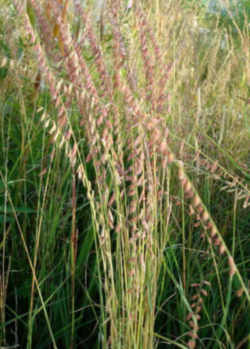Colorado State Grass
Blue Grama Grass

(Bouteloua gracilis)
Adoptedon May 20, 1987.
Blue Grama grass was adopted as the official state grass on May 20, 1987, by a resolution of the General Assembly. Blue Grama is a grass native to the state of Colorado, growing throughout many of the state's life zones on both sides of the Continental Divide. Grasslands are an important resource to the State of Colorado with considerable economic and conservation significance. A state grass was designated to help inform and educate citizens and tourists about this resource.
Colorado State Grass: Blue Grama Grass

Blue grama belongs to the grass family, Poaceae. Blue Grama is a native, perennial, warm-season, short grass that seldom grows taller than 12 to 20 inches. Blue Grama reproduces only by seed, and as the seed heads mature, they usually bend into a curve that resembles a human eyelash. It produces a low basal type growth that forms a bunchy sod. Blue Grama is grown throughout the Great Plains, and is found in association with buffalograss in the short grass prairies. It is more drought resistant and tolerates alkali conditions better than Sideoats Grama. Blue Grama produces highly palatable, nutritious forage that retains its feed value into the winter. Blue Grama does not produce an abundance of forage, and should not be grazed closer than 2 to 3 inches during the growing season
Colorado state officials introduce Blue Grama Grass as a home to indigenous flora and fauna; hence maintenance of the grassland is needed for a balanced eco system. The absence of grassland would also mean the absence of birds that bring seeds for further plant reproduction. Plant reproduction, as known to many, yields favorable results both for the ecosystem and the humans and animals living in it. The Blue Grama Grass aids in the purification of the air by absorbing considerable amounts of carbon dioxide - an air element that can be dangerous to one's health. Colorado, together with other places with significant quantities of grasslands, also benefit from Blue Grama Grass in cases of heavy rains and floods as the grass helps in the absorption of flood water. It was also established that these grasslands help in purifying water that basically come from taps which is used by people for cleaning, cooking, and sometimes, even for drinking purposes.Growth Characteristics
Low-growing grass with seed stalks 6 to 20 inches tall. It is a bunchgrass with short rhizomes, often forming an open sod by tillering. Starts growth in May or June, flowers in July to August, and reproduces primarily from tillers. Cannot tolerate shading by taller plants.
Seedhead
One-sided spike up to 2 inches long that is curved and comb-shaped at maturity. Spikelets are numerous, arranged in two rows on one side of the rachis, each containing one perfect floret and two imperfect florets reduced to bristles and scales; lemmas of perfect floret three-awned; glumes hairy and awn-tipped.
Leaves
The blades are narrow, mostly basal, sometime curled but generally flat, 1 to 6 inches long, usually glabrous but sometimes hairy on the margin near the base, folded to slightly rolled in the bud. Sheaths glabrous; collar with a few hairs at the margins; ligule a fringe of very short hairs; auricles absent.
Colorado Law
Blue Grama grass was adopted as the official state grass on May 20, 1987, by a resolution of the General Assembly.
Taxonomic Hierarchy: Blue Grama Grass
Kingdom: Plantae – Plants
Subkingdom: Tracheobionta – Vascular plants
Superdivision: Spermatophyta – Seed plants
Division: Magnoliophyta – Flowering plants
Class: Liliopsida – Monocotyledons
Subclass: Commelinidae
Order: Cyperales
Family: Poaceae ⁄ Gramineae – Grass family
Genus: Bouteloua Lag. – grama
Species: Bouteloua gracilis (Willd. ex Kunth) Lag. ex Griffiths – blue grama








